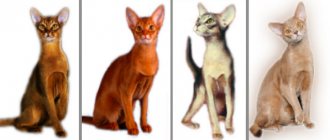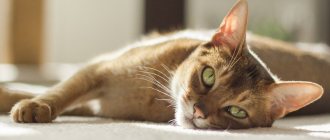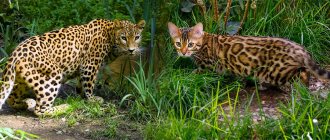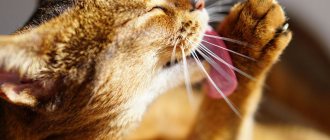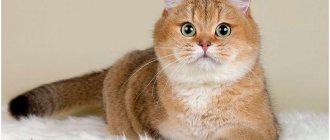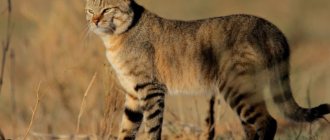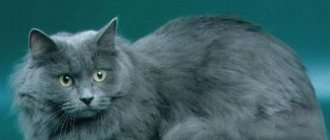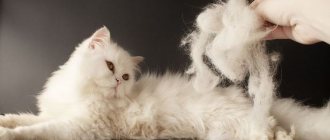WCF standard
The body
is muscular, of medium size, strong, flexible, dense, of medium length.
Tail
rather long, pointed, thick at the base.
Limbs
sinewy, long and slender. The paws are narrow and oval.
Head
wedge-shaped, medium proportions, soft contour, a slight notch at the transition to the muzzle is desirable. When viewed from the front, the muzzle is rounded and fits into a parabola, pointing downwards. Strong chin, medium length nose. The profile is without a stop, but not straight either, the forehead is slightly convex. Graceful neck.
Ears
large, widely and vertically set and wide at the base. The tips are rounded, with a “thumb print”, tassels on the ears are desirable.
Eyes
large, shiny, expressive, almond-shaped. Wide apart, slightly oblique (the outer corners of the eyes are higher than the inner ones). Color - pure, clear, juicy amber yellow or green, with eyelid rims.
Wool
short, thin and tight-fitting. Double or triple ticking. Dark ends of hair are preferred.
Flaws:
White spots, white medallion, too much white on the chest, closed necklaces, gray or too light undercoat, too little ticking, moire stripes. Pattern/stripes on the face or limbs. In dark colors there is no dark tip of the tail, dark “soles” on the hind legs, or dark rims on the eyelids.
Siamese type, round head, small or pointed ears, round eyes, mixed eye color, too noticeable feet.
| Body: 20 points Head, ears: 15 points Eyes: 10 points Color: 25 points Ticking: 15 points Texture: 10 points Condition: 5 points |
Colors:
Wild color, sorrel, blue, beige fawn, tortoiseshell, tortoiseshell sorrel, blue tortoiseshell, tortoiseshell fawn, black silver, sorrel silver, blue silver, fawn silver, blue tortoiseshell silver, tortoiseshell fawn silver
Character of Abyssinian cats
Abyssinian cats are very active animals that strive to explore the world around them. Their playfulness continues throughout their lives. Despite their predatory wild appearance, these cats are balanced, intelligent and intelligent, and very affectionate towards family members. Abyssinians do not show aggression, they usually do not extend their claws during games, and they are patient with children. Cats constantly patrol their territory in search of interesting activities, they like to climb as high as possible to observe - provide them with this opportunity.
Oh, box
Representatives of the breed are distinguished by neatness and cleanliness, they respect the rules established by the owner: they will not tear up furniture (especially if there is a scratching post), ride on curtains or knock down flower pots. But it is better to remove sharp, especially fragile objects, close windows on the top floors or protect them with a special net - in the heat of play, a cat can harm itself or make a mess.
Abyssinian cats have an independent character and self-esteem, so they will not tolerate disrespectful treatment and will not constantly sit on your hands. In character, they are a bit like dogs: they are loyal, play with pleasure, bringing back objects thrown by their owner. Abyssinian cats are good parents, so they do not need help in giving birth, feeding or raising their offspring. Smart, elegant pets require human attention and contact with the owner. Without this, the animal may become depressed and get sick.
n 25 WILD COLOR (RUDDY)
Color:
Body color is warm brown with black ticking.
The base of the hairs is dark orange, the belly and inner sides of the limbs are also dark orange or dark apricot, in accordance with the base of the hair on the rest of the body. The darker shade along the back forms a “wild” line. The tip of the tail and the "soles" of the hind legs from the pads of the feet to the hock joint should be rich black. Nose:
brick red with black edging.
Paw pads:
black.
Health and diseases of the Abyssinian cat
In general, Abyssinian cats are healthy, cheerful animals. When illnesses do occur, they are often associated with poor diet or genetic problems. Thus, in some lines, retinal retinopathy develops, due to which the Abyssinian cat becomes completely blind by the age of 5. This disease can be detected in a kitten in advance and responsible breeders weed out such individuals. Rarely, anemia can develop with age due to a lack of pyruvate kinase. Infrequently, renal amyloidosis occurs, leading to serious consequences for the health of the pet. The breed is prone to hip dysplasia and patella dislocations. You should brush your teeth regularly and make sure there is no licking. Bring your Abyssinian cat to the veterinarian periodically for a preventive appointment and do not self-medicate. With proper care, the animal will live 15-20 years.
Mother cat with kitten
b 25 SORREL (RED)
Color:
The body color is a brilliant copper-red with red-brown ticking. The base of the hairs is dark apricot, the belly and inner sides of the limbs are also dark apricot, in accordance with the base of the hair on the rest of the body. The darker shade along the back forms a “wild” line. The tip of the tail and the “soles” of the hind legs should be red-brown.
Nose:
Pink with red-brown edging
Paw pads:
Pink
What is ticking
The “coat” of an Abyssinian cat is dense, shiny, perfectly smooth, fits well to the body, short, without a pattern on the tail and paws. A distinctive feature, which is a kind of “business card” of the Abyssinian breed, is the coloring of each hair in different (dark, light) shades at the same time.
Such a non-standard, rare pattern is called ticking, and the reason for its occurrence lies in the special predominant agouti gene “A” (agouti) present in the genotype. It is thanks to him that the colors of Abyssinian cats do not have the characteristic tabby pattern inherent, for example, in British Shorthairs.
Ticking (zonal color) can be double or triple. Preference is given to the latter species, as it is the rarest.
The cat's entire body is evenly colored, but if you draw it against the fur, you can see a clear, bright undercoat, a tone lighter than the main color. Abyssinian cats do not acquire full coloring immediately, but after a year and a half. An Abyssinian kitten will not have such a bright aesthetic color at an early age.
At first, his fur looks dull and uncolored, but as he matures, the “ugly duckling” will turn into a magnificent royal individual with an amazingly beautiful, bright “fur coat.”
The coat of an adult animal should not have spots, rosettes or stripes, with the exception of white spots on the collar and chin. The richness of the ticking should not be obscured by the depth of the coloring.
If a cat of the Abyssinian breed has disadvantages in the form of differences between the main color and the shade of the paw pads, “rings” on the tail and paws, darkened spots under the chin, visually reminiscent of a closed necklace (marking), a “fur coat” of a dull gray cold tone, then these signs serve as grounds for disqualification.
Today, the International Association CFA (Cat Fanciers' Association) officially recognized the following colors of the Abyssinian cat breed: wild, blue, sorrel, fawn.
ns 25 BLACK SILVER
Color:
The base of the coat is pure white with black ticking.
A slightly darker shade along the back forms a line, it should appear especially dark. The tip of the tail and the "soles" of the hind legs from the pads of the feet to the hock joint should be rich black. Nose:
Brick red with black edging
Paw pads:
Black or brownish-black
Eye color:
Green or bluish-green, green preferred, with black edging.
Genetics of color
The unusual color of Abyssinian cats is a kind of calling card of the breed. It is caused by the presence in the genotype of animals of several genes, the combination or dominance of which determines coat color:
- The dominant agouti gene is “Ta”. It detects the presence of ticked hairs.
- Gene "Ttb". When dominant, it displays a “tiger” coloration.
- Gene "U". Smoothes out differences in coat color. When it is dominant, the pattern does not appear.
The color of a purebred Abyssinian cat depends on the combination of these genes planned by the breeders. Their influence has a prolonged effect. A kitten may be born with a pattern on its fur - spots or stripes, which will disappear over time.
Important! Experienced breeders claim that the presence of stripes in kittens is a defect of the breed. If the kitten has a gray, faded undercoat, this is evidence of a crossbreed.
The white spotting gene causes the appearance of spots on the belly and muzzle, white “socks” and the tip of the tail. These signs are not considered a defect, but they try not to use such animals for breeding.
bs 25 SORREL SILVER
Color:
The base of the coat is pure white with red-brown ticking.
A slightly darker shade along the back forms a line, it should appear especially dark. The tip of the tail and the "soles" of the hind legs from the pads of the feet to the hock joint should be a rich red-brown. Nose:
Brick red with brown edging
Paw pads:
Cinnamon or chocolate
Eye color:
Green or bluish-green, green preferred, with brown edging.
Photos of Blue Abyssinians
Possible deviations
- narrow or rounded skull;
- stripes on legs;
- drawing on the body;
- prominent cheekbones;
- light undercoat;
- fuzzy ticking;
- round eyes;
- small ears;
- flabby muscles;
- short legs and tail;
- lack of dark eyeliner around the eyelids;
- light areas on the coat;
- pointed muzzle;
- "fox" look.
as 25 BLUE SILVER
Color:
The base of the coat is pure white with steel blue ticking.
A slightly darker shade along the back forms a line, it should appear especially dark. The tip of the tail and the "soles" of the hind legs from the pads of the feet to the hock joint should be a rich steel blue color. Nose:
Brick red with blue edging
Paw pads:
Bluish-gray
Eye color:
Green or bluish-green, green preferred, with black edging.
How do eye color and coloring relate?
The eye color of Abyssinian cats directly depends on the main color of their coat:
- Abyssinians of wild colors have eyes of hazel, golden or green;
- The Abyssinian faun cat has eyes that strictly correspond to the standard color. Their color can vary from golden to green;
- The Abyssinian sorrel is most often found with golden or copper eyes. Although green or dark hazel eyes are allowed for this color;
- The blue Abyssinian has golden and copper eyes. Green and nutty shades are less common.
cs 25 FAWN SILVER
Color:
The base of the coat is pure white with warm cream ticking.
A slightly darker shade along the back forms a line, it should appear especially dark. The tip of the tail and the “soles” of the hind legs from the pads of the feet to the hock joint should be a rich, warm cream color. Nose:
Pink with dark pink edging
Paw pads:
Dark pink
Eye color:
Green or bluish-green, green preferred, with black edging.
Note: Any shade of cream or brown in the undercoat is a fault on all silver varieties.
Health
Unfortunately, like other Abyss cats, they are not perfect and have their weaknesses, such as kidneys, gums and eyes. Remember to visit veterinarians periodically to check your pet's health.
Puberty in Abyssian cats can begin at 4 months, do not be alarmed, this is just a feature of this breed.
The average life expectancy of these cats is 14-15 years.
CFA Standard
GENERAL CHARACTERISTICS:
The general impression of the ideal Abyssinian is an elegant medium-sized cat with an original color and royal dignity. The Abyssinian is flexible, strong, muscular, energetic and inquisitive in all conditions. This is a well-balanced cat both physically and emotionally.
HEAD:
A modified wedge with rounded outlines - all lines and planes have smooth transitions and contours. The transition from the forehead to the nose is pronounced, the forehead is full, wide between the ears and smoothly blending into the neck.
MUZZLE:
rounded, without pinch. The chin is wide and should not be slanted or protruding. Adult cats have more developed jaws.
EARS:
alert, large, moderately broadly directed, broad and cupped at the base, open. The hair on the ears is short and fine, with clear, contrasting ticking.
EYES:
almond-shaped, large, shiny and expressive. Neither rounded nor slanted. The eyes are outlined with a dark line surrounded by a light tone.
BODY:
medium length, flexible and graceful, the muscles are well defined, but not prominent or coarse. The body structure is between compact and elongated. Proportion and balance are more important than size.
LEGS and FEET:
proportional, graceful, the Abyssinian seems to stand on his toes. The paws are compact, small in size and oval in shape. Toes: five in front and four in back.
TAIL:
thick at the base, gradually tapering towards the tip.
WOOL:
soft, silky, original texture - dense and elastic to the touch, shiny. Medium length, close to the body. Hairs with zonal coloring - two or three colored rings alternating with a lighter tone.
FLAWS:
elongated or narrow head. Dark colored rings on the legs, open necklaces on the chest and stripes on the tail. Cool or gray shades in color. White undercoat in blue and fawn colors.
DISQUALIFICATION:
white medallion, or white anywhere except the chin and eye rims, tail defects, closed necklace on the chest, gray tone at the base of the hair throughout the body, any black hairs on the red coat, incorrect number of toes. Unrecognized color.
Abyssinian color:
The coat color is warm and luminous. The original color is formed by hairs with contrasting stripes, bright even at the base of the hair. The base color is bright and clear, a deeper tone is desirable, a darker stripe along the ridge is allowed unless it is very contrasting. Preference is given to animals without patterns on the lower part of the body, legs and tail. On the muzzle there are dark lines around the eyes and eyebrows, on the cheekbones, shading and dots on the underarms. The eyes are outlined with a dark line, surrounded by light glasses. Eye color - gold or green, monotony and depth of color are encouraged.
Wild color:
black on red-brown tone.
Red:
chocolate on a red background.
Blue:
blue on a beige tone.
Fawn:
cocoa color on a light beige tone.
Silver
- all of the above color variations on a silver tone (not recognized).
All colors: Nose
- pink with a liner in the color of the main color;
Paw pads
- dark in the color of the main color.
| Head (25) Muzzle………. 6 Head……….. 6 Ears………… 7 Eye shape……. 6 | Body (30) Body………. 15 Legs and paws .. 10 Tail ……….. 5 | Wool (10) Texture…….. 10 | Color (35) Color……….. 15 Ticking…….. 15 Eye color….. 5 |
Abyssinian cat fur care
Abyssinian cats are ideal for indoor keeping. They have good health, practically do not shed (thanks to their short hair), are completely unpretentious in food, and do not cause any trouble to their owners.
But they, like any other purebred cats, need to be provided with proper coat care:
- Once or twice a week, your pet must be combed with a special comb with metal teeth;
- During the spring molting period, it is recommended to periodically bathe cats and brush them frequently;
- For bathing Abyssinians of all colors, a special shampoo is used, and the water is changed 2-3 times during the bathing process. This breed loves to swim, but hates showering.
In order for your pet to have perfect fur, it needs to have a proper diet, be given the opportunity to exercise a lot and keep it clean.
In conclusion, it is worth noting that Abyssinian cats are distinguished by: their regal coloring, the arrogant look of their huge expressive eyes, and their nobility. They conquer their owners with obedience, friendliness, affection and warmth. This breed is characterized by loyalty and affection for its owners, and does not tolerate loneliness at all. Therefore, if you are often not at home, it is recommended to get two cats at once, and not necessarily of the same breed. Instead of a cat, you can get any other pet (just not a parrot or rodents), since Abyssinians get along well with all animals and always try to find contact with them.
Colors according to TICA standard
Ruddy:
Orange-brown, covered with two or three stripes of black or dark brown. The upper lip is darker, with orange-brown skin. The outer part of the body is covered with shorter hair and should have at least one ticking stripe. Dark shading along the spine is allowed if it is fully ticked. The inside of the body, chest, inside of the legs should be red-brown without ticking, medallions or spots. Color variations range from apricot to deeper, with deeper flowers being preferred. The tail should be black with no rings or gray spots. Paw pads are black or dark brown with black between the toes. Eye color - gold, green, copper or gazelle. Richer and deeper tones are preferred. The nose is brick red.
Sorrel (Cinnamon):
The appearance is orange-brown with red ticking and chocolate brown. The tail is chocolate brown. Deeper sorrel (cinnamon) colors and richer ticking are preferred. The paw pads are pink with brown between the toes. Eye color - gold, green, copper or gazelle. Richer and deeper tones are preferred. The nose is pink.
Blue
A warm, soft raw blue with darker blue ticking. The base hair, lower body, chest, inner legs are cream. The spine is a darker shade than the body color. The tail is a darker shade of blue. Good full ticking is preferred. The paw pads are lilac-blue with blue between the toes. Eye color - gold, green, copper or gazelle. Richer and deeper tones are preferred. The nose is dark pink.
Fawn
A warm pink-beige with a powdery effect, ticked into a deeper, darker pink-beige. Base hair, lower body, chest, inner legs are fawn. The spine is a darker shade than the body color. The tail is a darker shade of pink-beige. Good full ticking is preferred. The paw pads are lilac-pink with pink-beige between the toes. Eye color - gold, green, copper or gazelle. Richer and deeper tones are preferred. The nose is lilac-pink.
What else could they be?
International associations recognize only four colors that are possible in this breed of domestic animals. These include:
- faun (another name for “fawn”, a delicate pinkish-cream shade of wool or the color of bleached cocoa);
- wild (the most common, spectacular and very attractive, combines all shades of ocher);
- blue (under normal conditions, a gray fur coat from a certain angle gives a blue tint, especially on the back, along the spine);
- sorel (a unique coat color, it is inherent only to pets of this breed, it is a rich red-brick color that looks attractive and unusual).
In addition to the officially recognized ones, silver and lilac colors are considered very popular today. The price of a kitten with this coat color is quite high, even in relation to standard coat colors. Some breeders specifically use carriers to produce litters with unusual coat colors.
Regardless of the color of their fur coat, Abyssinians have a very kind disposition, love their owners and prefer to spend time in their company. They do not like to be left alone and are almost always on the move. You will never be bored with such a pet. At the same time, their regal gait and noble appearance invariably attract the gaze of others.
Similar articles
NBC colors. Review
Silver cats only have an undercoat that differs from tabby cats, with four ticking colors that are the same for both species. In all silver variations, the preferred undercoat color is white. The ticking matches the color of the coat and gives the overall appearance of a silver color. An ivory undercoat is also acceptable. Yellow or brown spots on the chest, belly, or inside of the legs are not desirable, although they are not considered a fault.
Silver: The ticking or dark stripes on the coat are black. The undercoat is white and silver. The tail is completely cinnamon color without rings. Eye and pad color: same as Ruddy. The nose is pink.
Silver-Cinnamon The ticking or dark stripes on the coat are the color of cinnamon. The undercoat is white and silver. The tail is completely black without rings. The color of the eyes and pads, as well as the nose: the same as Sorrel.
Blue-Silver: The ticking or dark stripes on the coat are blue-gray. The undercoat is white and silver. The tip of the nose and the color of the spine are like Blue. The color of the eyes and pads, as well as the nose: the same as Blue.
Fawn Silver: The ticking or dark stripes on the coat are fawn colors (pink beige).
The undercoat is white and silver. The tip of the nose and the color of the spine are like Fawn's. The color of the eyes and pads, as well as the nose: the same as Fawn. Abyssinian cat standards https://abyssin.net/wp-content/uploads/2016/03/cat10.jpg https://abyssin.net/wp-content/uploads/2016/03/cat10.jpg2018-10-08T22:35 :47+03:00 abyssinAbout the Abyssinian breed articlesWCF standard The body is muscular, medium size, strong, flexible, dense, of medium length. The tail is quite long, pointed, thick at the base. The limbs are sinewy, long and slender. The paws are narrow and oval. The head is wedge-shaped, of medium proportions, soft contour, a slight notch at the transition to the muzzle is desirable. When viewed from the front, the muzzle is rounded and fits into a parabola, pointing downwards. Strong...abyssinPhilip Sirotin [email protected] Cattery
History of the Abyssinian cat breed
Abyssinian cat
Abyssinian cats have become popular quite a long time ago, but researchers have not been able to find out the exact geographical region and time of origin of the breed. Several main versions have been formulated. The first said that the animals first came to Europe after the war between England and Abyssinia (Ethiopia) in 1868, where they originated from. As the main evidence, supporters of the theory used an English book from the second half of the 19th century with a lithograph of a cat named Zulu, which was acquired by Captain Barrett-Lenard after the end of the military campaign. Despite the external resemblance to modern representatives of the breed, there is no convincing evidence that the cat depicted was actually an Abyssinian.
Other researchers believed that the animals had Egyptian roots, since ancient figurines depicted similar pets. Perhaps they were the ones worshiped by one of the most mysterious civilizations in the world. At the same time, genetic analysis carried out by scientists showed that these cats were always closely related to animals that lived on the coast of the Indian Ocean. In any case, the ancient line of the breed was considered extinct. Modern Abyssinian cats first appeared at shows in Great Britain in 1871, finishing third among 170 other breeds.
A detailed description of these animals was made in 1882, the initial standard was formed by 1889, and official recognition with entry into the stud book awaited the breed only in 1896. In the early 1900s, the first representatives came to America, which ensured the survival of the breed in the future. The Second World War almost completely wiped out Abyssinian cats from the European continent - only about a dozen individuals remained in the UK. It was the American specimens that helped restore the population.
Due to the changes that cats managed to undergo in the USA, after the war it was necessary to recognize the existence of two branches that have survived to this day: American and European. These animals managed to gain worldwide fame, although they remained exotic in the CIS. According to the CFA, Abyssinian cats ranked second in popularity among short-haired breeds in the United States and Europe in 2012.
